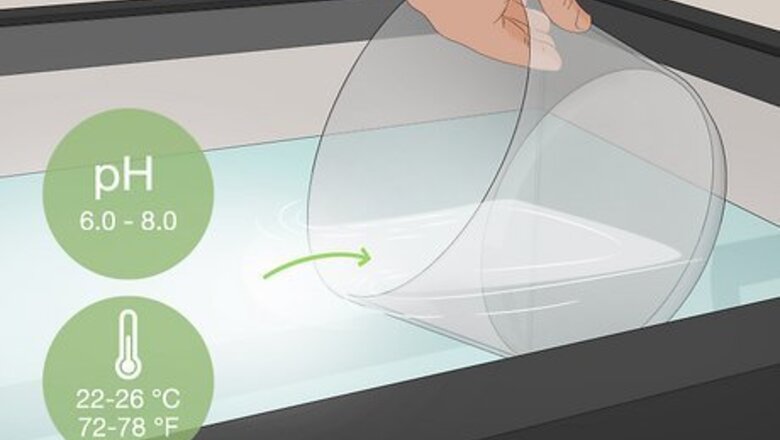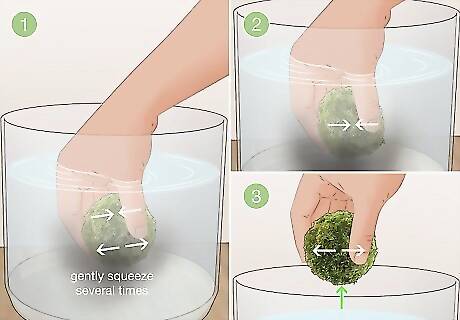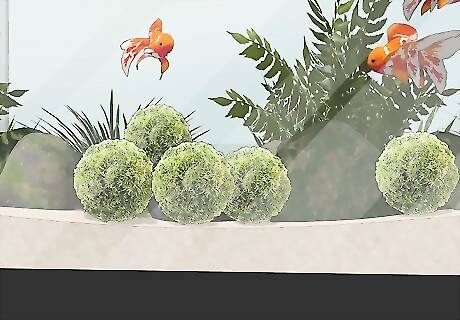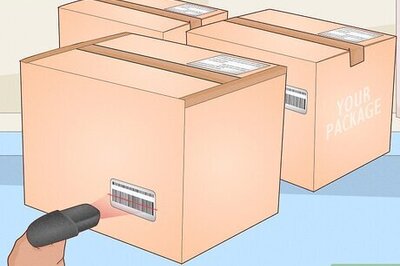
views
X
Expert Source
Luke LeskovisekAquarium Expert
Expert Interview
Conducting Basic Cleaning

Create a bucket of aquarium water to clean your moss ball in. Pour purified, dechlorinated, and aquarium-ready water into a bucket. Be sure that it's 72 to 78 °F (22 to 26 °C) and has a pH in the range of 6.0 to 8.0. Purchase a water thermometer from a pet store or online supplier if you don't have one already. Always add ½ cup (118 grams) of sea salt per 1 gallon (3.8 L) for saltwater aquariums. Conduct cleaning after swapping your aquarium water so you can use the excess replacement water for cleaning your moss ball.

Squish your moss ball into your bucket of clean aquarium water. Submerge your moss ball in your bucket of aquarium water. Now, start gently squeezing it to remove the dirt it has absorbed. After your final squeeze, remove the ball from the bowl before releasing your grip to avoid it sucking up dirty water. Don't repeatedly squeeze the moss ball in the same spot or you might damage it.

Roll the moss ball into a spherical shape with your palms. After cleaning your moss ball, it might be out of shape. In some cases, it might even break apart. Regardless, gently roll it together between the palms of your hands to put it back into its spherical shape. This will prevent it from falling it apart by helping the algae strands connect with each other. Be as gentle as you can when rolling your moss ball and don't apply too much pressure. If you break a piece off that can't be reattached, roll it up as a separate ball.

Place your moss ball back into the aquarium. When you put your moss ball back into the aquarium, it should float to the surface. This means that there is no more water inside it, which is what you want. Give it some time and it will fill with your fresh aquarium water and sink to the bottom. If your moss ball sinks to the bottom of the aquarium right away, give it another clean to remove dirty water. Just make sure to remove it from your cleaning tank while keeping a grip on it after the final squeeze to prevent it from sucking up water.
Following Best Cleaning Practices

Inspect your moss ball for brown and gray colors every 1 to 2 weeks. If your moss ball lives alongside other animals that tend to leave waste or dig up sand, check its cleanliness once a week or more. If your moss ball is housed alone, it won't get dirty very often and you can check it every other week. Remove it from the tank regularly and inspect each side of it to check its cleanliness. If it's dirty it will likely be brown or gray, which means it's time for a clean! If your aquarium has algae-eating fish, shrimp, or snails, you likely won't have to clean your moss ball as often.

Swap 25 percent of the tank water weekly to keep your moss ball fresh. Just like fish, your aquatic moss ball requires clean water to stay fresh. Remove the water each week either manually with a bucket or with a siphon if you want to avoid heavy lifting. Afterward, replace the water with dechlorinated and purified water. If your moss ball is in a tank with fish, always use a water purifier. Use tap water if your area has low water hardness and your moss ball is alone. If you're adding cold water, make sure the temperature is acceptable for the species of fish in your tank. For saltwater tanks, mix ½ cup (118 grams) of sea salt per 1 gallon (3.8 L) of water.

Keep your moss ball in indirect sunlight and rotate it weekly. All moss balls need to make food is household lighting, but placing them in indirect sunlight is fine as well. Avoid placing your moss balls in direct sunlight and rotate them every week to ensure equal light exposure. If your moss ball is brown on just one side, it's likely not getting enough sunlight. Rotate it so that the brown side faces the light. Once it becomes green, keep rotating it so that each side gets enough light.

Remove invasive algae with water and tweezers. If you notice that your moss ball is getting slippery or slimy, it might be affected by invasive algae that are feeding on its healthy algae. Start by running your moss ball under tepid tap water. Wait until it fills, squeeze it out, and repeat until it slowly washes off. If the layer is very visible, use a pair of tweezers to pick it off. For saltwater tanks, increase the salt levels in your water to help remove the slimy layer.

Replace dark moss balls if you can't get rid of the dirt and algae. A moss ball that is turning or has turned black is experiencing improper care and neglect or is being attacked by hostile algae. If chemical cleaning and physical removal with tweezers doesn't work, throw out your moss ball and swap it with a new one. Moss balls can last up to 100 years with proper care.



















Comments
0 comment